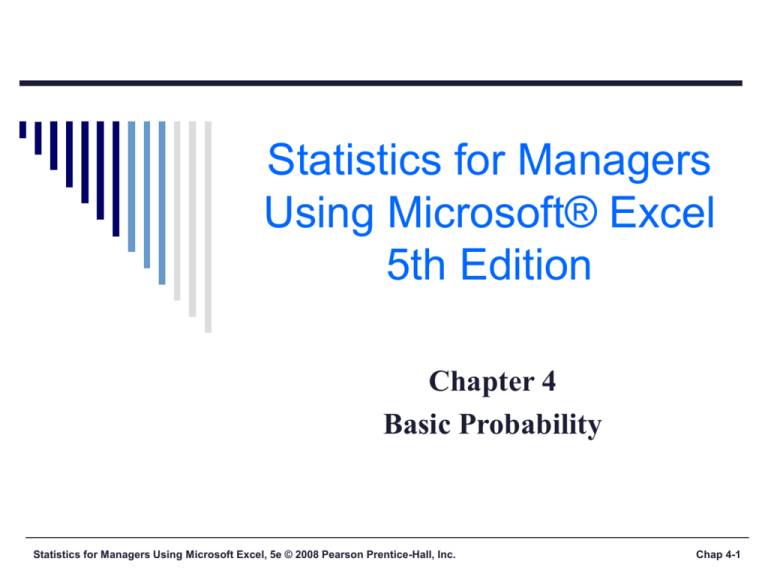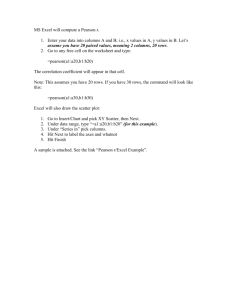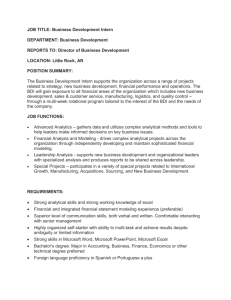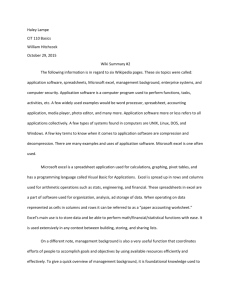
Statistics for Managers
Using Microsoft® Excel
5th Edition
Chapter 4
Basic Probability
Statistics for Managers Using Microsoft Excel, 5e © 2008 Pearson Prentice-Hall, Inc.
Chap 4-1
Learning Objectives
In this chapter, you will learn:
Basic probability concepts
Conditional probability
To use Bayes’ Theorem to revise
probabilities
Statistics for Managers Using Microsoft Excel, 5e © 2008 Pearson Prentice-Hall, Inc.
Chap 4-2
Definitions
Probability: the chance that an uncertain
event will occur (always between 0 and 1)
Event: Each possible type of occurrence or
outcome
Simple Event: an event that can be described
by a single characteristic
Sample Space: the collection of all possible
events
Statistics for Managers Using Microsoft Excel, 5e © 2008 Pearson Prentice-Hall, Inc.
Chap 4-3
Types of Probability
There are three approaches to assessing the probability of an
uncertain event:
1. a priori classical probability: the probability of an event is based
on prior knowledge of the process involved.
2. empirical classical probability: the probability of an event is
based on observed data.
3. subjective probability: the probability of an event is determined by
an individual, based on that person’s past experience, personal
opinion, and/or analysis of a particular situation.
Statistics for Managers Using Microsoft Excel, 5e © 2008 Pearson Prentice-Hall, Inc.
Chap 4-4
Calculating Probability
1. a priori classical probability
Probabilit y of Occurrence
X
number of ways the event can occur
T
total number of possible outcomes
2. empirical classical probability
Probabilit y of Occurrence
number of favorable outcomes observed
total number of outcomes observed
These equations assume all outcomes are equally likely.
Statistics for Managers Using Microsoft Excel, 5e © 2008 Pearson Prentice-Hall, Inc.
Chap 4-5
Example of a priori
classical probability
Find the probability of selecting a face card (Jack, Queen,
or King) from a standard deck of 52 cards.
Probabilit y of Face Card
X
number of face cards
T
total number of cards
X
12 face cards
3
T
52 total cards 13
Statistics for Managers Using Microsoft Excel, 5e © 2008 Pearson Prentice-Hall, Inc.
Chap 4-6
Example of empirical
classical probability
Find the probability of selecting a male taking statistics
from the population described in the following table:
Taking
Stats
Not Taking
Stats
Total
Male
84
145
229
Female
76
134
210
160
279
439
Total
Probabilit y of Male Taking Stats
number of males taking stats 84
0.191
total number of people
439
Statistics for Managers Using Microsoft Excel, 5e © 2008 Pearson Prentice-Hall, Inc.
Chap 4-7
Examples of Sample Space
The Sample Space is the collection of all possible
events
ex. All 6 faces of a die:
ex. All 52 cards in a deck of cards
ex. All possible outcomes when having a child:
Boy or Girl
Statistics for Managers Using Microsoft Excel, 5e © 2008 Pearson Prentice-Hall, Inc.
Chap 4-8
Events in Sample Space
Simple event
An outcome from a sample space with one
characteristic
ex. A red card from a deck of cards
Complement of an event A (denoted A/)
All outcomes that are not part of event A
ex. All cards that are not diamonds
Joint event
Involves two or more characteristics simultaneously
ex. An ace that is also red from a deck of cards
Statistics for Managers Using Microsoft Excel, 5e © 2008 Pearson Prentice-Hall, Inc.
Chap 4-9
Visualizing Events in
Sample Space
Contingency Tables:
Ace
Not
Ace
Total
Black
2
24
26
Red
2
24
26
Total
4
48
52
Tree Diagrams:
Sample
Space
Full Deck
of 52 Cards
Statistics for Managers Using Microsoft Excel, 5e © 2008 Pearson Prentice-Hall, Inc.
2
24
2
24
Chap 4-10
Definitions
Simple vs. Joint Probability
Simple (Marginal) Probability refers to the
probability of a simple event.
ex. P(King)
Joint Probability refers to the probability of
an occurrence of two or more events.
ex. P(King and Spade)
Statistics for Managers Using Microsoft Excel, 5e © 2008 Pearson Prentice-Hall, Inc.
Chap 4-11
Definitions
Mutually Exclusive Events
Mutually exclusive events are events that cannot occur
together (simultaneously).
example:
A = queen of diamonds; B = queen of clubs
Events A and B are mutually exclusive if only one card is
selected
example:
B = having a boy; G = having a girl
Events B and G are mutually exclusive if only one child is
born
Statistics for Managers Using Microsoft Excel, 5e © 2008 Pearson Prentice-Hall, Inc.
Chap 4-12
Definitions
Collectively Exhaustive Events
Collectively exhaustive events
One of the events must occur
The set of events covers the entire sample space
example:
A = aces; B = black cards; C = diamonds; D = hearts
Events A, B, C and D are collectively exhaustive (but not
mutually exclusive – a selected ace may also be a heart)
Events B, C and D are collectively exhaustive and also
mutually exclusive
Statistics for Managers Using Microsoft Excel, 5e © 2008 Pearson Prentice-Hall, Inc.
Chap 4-13
Computing Joint and
Marginal Probabilities
The probability of a joint event, A and B:
P( A and B)
number of outcomes satisfying A and B
total number of elementary outcomes
Computing a marginal (or simple) probability:
P(A) P(A and B1 ) P(A and B2 ) P(A and Bk )
Where B1, B2, …, Bk are k mutually exclusive and
collectively exhaustive events
Statistics for Managers Using Microsoft Excel, 5e © 2008 Pearson Prentice-Hall, Inc.
Chap 4-14
Example:
Joint Probability
P(Red and Ace)
number of cards that are red and ace
2
total number of cards
52
Ace
Not
Ace
Total
Black
2
24
26
Red
2
24
26
Total
4
48
52
Statistics for Managers Using Microsoft Excel, 5e © 2008 Pearson Prentice-Hall, Inc.
Chap 4-15
Example:
Marginal (Simple) Probability
P(Ace)
P( Ace and Re d) P( Ace and Black )
Ace
Not Ace
Total
Black
2
24
26
Red
2
24
26
Total
4
48
52
Statistics for Managers Using Microsoft Excel, 5e © 2008 Pearson Prentice-Hall, Inc.
2
2
4
52 52 52
Chap 4-16
Joint Probability Using a
Contingency Table
Event
B1
Event
B2
Total
A1
P(A1 and B1)
P(A1 and B2)
P(A1)
A2
P(A2 and B1)
P(A2 and B2)
P(A2)
Total
P(B1)
P(B2)
1
Joint Probabilities
Marginal (Simple) Probabilities
Statistics for Managers Using Microsoft Excel, 5e © 2008 Pearson Prentice-Hall, Inc.
Chap 4-17
Probability
Summary So Far
Probability is the numerical measure of the
likelihood that an event will occur.
The probability of any event must be
between 0 and 1, inclusively
0 ≤ P(A) ≤ 1 for any event A.
1
Certain
.5
The sum of the probabilities of all mutually
exclusive and collectively exhaustive
events is 1.
P(A) + P(B) + P(C) = 1
A, B, and C are mutually exclusive and
collectively exhaustive
0
Statistics for Managers Using Microsoft Excel, 5e © 2008 Pearson Prentice-Hall, Inc.
Impossible
Chap 4-18
General Addition Rule
General Addition Rule:
P(A or B) = P(A) + P(B) - P(A and B)
If A and B are mutually exclusive, then
P(A and B) = 0, so the rule can be simplified:
P(A or B) = P(A) + P(B)
for mutually exclusive events A and B
Statistics for Managers Using Microsoft Excel, 5e © 2008 Pearson Prentice-Hall, Inc.
Chap 4-19
General Addition Rule
Example
Find the probability of selecting a male or a statistics student
from the population described in the following table:
Taking Stats
Not Taking Stats
Total
Male
84
145
229
Female
76
134
210
160
279
439
Total
P(Male or Stat) = P(M) + P(S) – P(M AND S)
= 229/439 + 160/439 – 84/439 = 305/439
Statistics for Managers Using Microsoft Excel, 5e © 2008 Pearson Prentice-Hall, Inc.
Chap 4-20
Conditional Probability
A conditional probability is the probability of one event,
given that another event has occurred:
P(A | B)
P(A and B)
P(B)
P(B | A)
P(A and B)
P(A)
The conditional
probability of A given
that B has occurred
The conditional
probability of B given
that A has occurred
Where P(A and B) = joint probability of A and B
P(A) = marginal probability of A
P(B) = marginal probability of B
Statistics for Managers Using Microsoft Excel, 5e © 2008 Pearson Prentice-Hall, Inc.
Chap 4-21
Computing Conditional
Probability
Of the cars on a used car lot, 70% have air
conditioning (AC) and 40% have a CD
player (CD). 20% of the cars have both.
What is the probability that a car has a CD
player, given that it has AC ?
We want to find P(CD | AC).
Statistics for Managers Using Microsoft Excel, 5e © 2008 Pearson Prentice-Hall, Inc.
Chap 4-22
Computing Conditional
Probability
CD
No CD
Total
AC
0.2
0.5
0.7
No
AC
0.2
0.1
0.3
Total
0.4
0.6
1.0
Given
P(CD and AC) .2
P(CD | AC)
.2857
P(AC)
.7
Given AC, we only consider the top row (70% of the cars). Of these,
20% have a CD player. 20% of 70% is about 28.57%.
Statistics for Managers Using Microsoft Excel, 5e © 2008 Pearson Prentice-Hall, Inc.
Chap 4-23
Computing Conditional
Probability: Decision Trees
.2
.4
Given CD or
no CD:
All
Cars
.2
.4
.5
.6
.1
.6
Statistics for Managers Using Microsoft Excel, 5e © 2008 Pearson Prentice-Hall, Inc.
P(CD and AC) = .2
P(CD and AC/) = .2
P(CD/ and AC) = .5
P(CD/ and AC/) = .1
Chap 4-24
Computing Conditional
Probability: Decision Trees
.2
.7
Given AC or
no AC:
All
Cars
.5
.7
.2
.3
.1
.3
Statistics for Managers Using Microsoft Excel, 5e © 2008 Pearson Prentice-Hall, Inc.
P(AC and CD) = .2
P(AC and CD/) = .5
P(AC/ and CD) = .2
P(AC/ and CD/) = .1
Chap 4-25
Statistical Independence
Two events are independent if and only if:
P(A | B) P(A)
Events A and B are independent when the
probability of one event is not affected by the
other event
Statistics for Managers Using Microsoft Excel, 5e © 2008 Pearson Prentice-Hall, Inc.
Chap 4-26
Multiplication Rules
Multiplication rule for two events A and B:
P(A and B) P(A | B) P(B)
If A and B are independent, then P(A | B) P(A)
and the multiplication rule simplifies to:
P(A and B) P(A) P(B)
Statistics for Managers Using Microsoft Excel, 5e © 2008 Pearson Prentice-Hall, Inc.
Chap 4-27
Multiplication Rules
Suppose a city council is composed of 5
democrats, 4 republicans, and 3 independents.
Find the probability of randomly selecting a
democrat followed by an independent.
P(I and D) P(I | D) P(D) (3/11)(5/1 2) 5/44 .114
Note that after the democrat is selected (out of 12
people), there are only 11 people left in the
sample space.
Statistics for Managers Using Microsoft Excel, 5e © 2008 Pearson Prentice-Hall, Inc.
Chap 4-28
Marginal Probability Using
Multiplication Rules
Marginal probability for event A:
P(A) P(A | B1 ) P(B1 ) P(A | B2 ) P(B2 ) P(A | Bk ) P(Bk )
Where B1, B2, …, Bk are k mutually exclusive
and collectively exhaustive events
Statistics for Managers Using Microsoft Excel, 5e © 2008 Pearson Prentice-Hall, Inc.
Chap 4-29
Bayes’ Theorem
Bayes’ Theorem is used to revise previously
calculated probabilities based on new
information.
Developed by Thomas Bayes in the 18th
Century.
It is an extension of conditional probability.
Statistics for Managers Using Microsoft Excel, 5e © 2008 Pearson Prentice-Hall, Inc.
Chap 4-30
Bayes’ Theorem
P(Bi | A)
P(A | Bi )P(B i )
P(A | B1 )P(B1 ) P(A | B2 )P(B 2 ) P(A | Bk )P(B k )
where:
Bi = ith event of k mutually exclusive and
collectively exhaustive events
A = new event that might impact P(Bi)
Statistics for Managers Using Microsoft Excel, 5e © 2008 Pearson Prentice-Hall, Inc.
Chap 4-31
Bayes’ Theorem
Example
A drilling company has estimated a 40% chance of
striking oil for their new well.
A detailed test has been scheduled for more
information. Historically, 60% of successful wells
have had detailed tests, and 20% of unsuccessful
wells have had detailed tests.
Given that this well has been scheduled for a
detailed test, what is the probability that the well
will be successful?
Statistics for Managers Using Microsoft Excel, 5e © 2008 Pearson Prentice-Hall, Inc.
Chap 4-32
Bayes’ Theorem
Example
Let S = successful well
U = unsuccessful well
P(S) = .4 , P(U) = .6 (prior probabilities)
Define the detailed test event as D
Conditional probabilities:
P(D|S) = .6
P(D|U) = .2
Goal: To find P(S|D)
Statistics for Managers Using Microsoft Excel, 5e © 2008 Pearson Prentice-Hall, Inc.
Chap 4-33
Bayes’ Theorem
Example
Apply Bayes’ Theorem:
P(D | S)P(S)
P(D | S)P(S) P(D | U)P(U)
(.6)(.4)
(.6)(.4) (.2)(.6)
.24
.667
.24 .12
P(S | D)
So, the revised probability of success, given that this
well has been scheduled for a detailed test, is .667
Statistics for Managers Using Microsoft Excel, 5e © 2008 Pearson Prentice-Hall, Inc.
Chap 4-34
Bayes’ Theorem
Example
Given the detailed test, the revised probability of a
successful well has risen to .667 from the original estimate
of 0.4.
Event
Prior
Prob.
Conditional
Prob.
S (successful)
.4
.6
.4*.6 = .24 .24/.36 = .667
U (unsuccessful)
.6
.2
.6*.2 = .12 .12/.36 = .333
= .36
Statistics for Managers Using Microsoft Excel, 5e © 2008 Pearson Prentice-Hall, Inc.
Joint
Prob.
Revised
Prob.
Chap 4-35
Chapter Summary
In this chapter, we have
Discussed basic probability concepts.
Sample spaces and events, contingency tables, simple
probability, and joint probability
Examined basic probability rules.
General addition rule, addition rule for mutually
exclusive events, rule for collectively exhaustive events.
Defined conditional probability.
Statistical independence, marginal probability, decision
trees, and the multiplication rule
Discussed Bayes’ theorem.
Statistics for Managers Using Microsoft Excel, 5e © 2008 Pearson Prentice-Hall, Inc.
Chap 4-36






